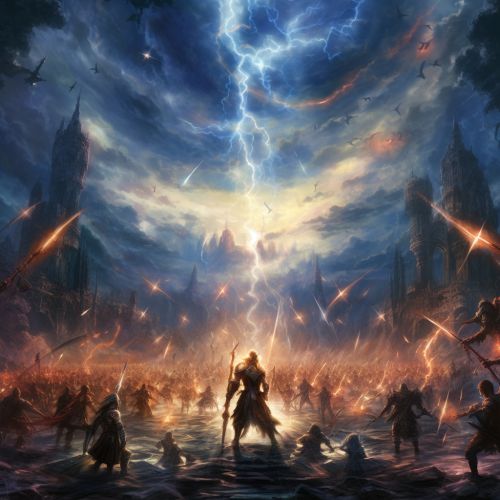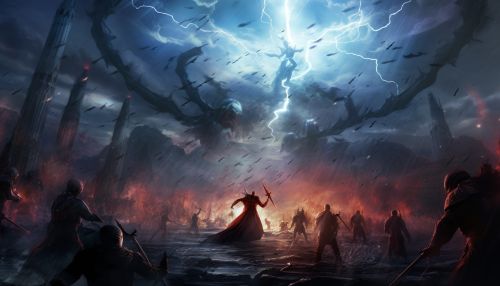Titanomachy
Overview
The Titanomachy was a ten-year series of battles fought in Thessaly, constituting one of the 'War of the Titans' in Greek mythology. This cataclysmic conflict was fought by the Titans, a race of powerful deities that were descendants of Gaia and Uranus, against the Olympians, a younger generation of divine beings led by Zeus. The Titans, who ruled the cosmos during the Golden Age, were ultimately overthrown by the Olympians, ushering in a new era of Greek mythology.


The Titans
The Titans were a group of twelve powerful deities that ruled during the mythological Golden Age. They were the offspring of the primordial deities Uranus (Sky) and Gaia (Earth). The Titans included such figures as Oceanus, Tethys, Hyperion, Theia, Coeus, Phoebe, Cronus, Rhea, Mnemosyne, Themis, Crius, and Iapetus. They were known for their immense strength and were associated with various aspects of the natural world, from the ocean to the sun.
The Olympians
The Olympians were a younger generation of gods, the principal deities of the Greek pantheon, who came to power after overthrowing the Titans. They were the children of the Titans Cronus and Rhea, and were led by Zeus. The other Olympians included Hera, Poseidon, Demeter, Hestia, and Hades. Later, other gods like Athena, Apollo, Artemis, Hermes, Dionysus, Hephaestus, and Aphrodite were also considered Olympians.
The Conflict
The Titanomachy was sparked by a prophecy heard by Cronus, the leader of the Titans. The prophecy foretold that one of Cronus' children would overthrow him, just as he had overthrown his own father, Uranus. In an attempt to prevent this prophecy from coming true, Cronus swallowed each of his children as they were born. However, Rhea managed to save the youngest, Zeus, by hiding him away and giving Cronus a stone wrapped in swaddling clothes to swallow instead.
When Zeus had grown to adulthood, he returned to free his siblings and challenge his father. With the help of Metis, a Titaness, Zeus tricked Cronus into regurgitating his swallowed children. Now free, the Olympians, also known as the younger gods, declared war on the Titans, marking the beginning of the Titanomachy.
The Battle
The Titanomachy was a brutal and violent conflict, with both sides possessing immense strength and power. The Olympians were initially at a disadvantage, as they were fewer in number and less experienced. However, they had several advantages that would ultimately lead to their victory. First, they were led by Zeus, who had been raised away from the influence of the Titans and had a unique perspective on their rule. Second, they had allies in the form of the Hecatoncheires and the Cyclopes, who had been freed from Tartarus by Zeus.
The Hecatoncheires were giants with fifty heads and one hundred arms, while the Cyclopes were one-eyed giants skilled in crafting. The Cyclopes provided the Olympians with powerful weapons, including Zeus's thunderbolts, Poseidon's trident, and Hades' helmet of invisibility. With these weapons and allies, the Olympians were able to match the Titans in battle.
The Aftermath
The Titanomachy ended with the victory of the Olympians. The Titans were overthrown, and many of them were cast into Tartarus, a deep abyss used as a dungeon of torment for the wicked and a prison for the Titans. Zeus and his siblings took control of the cosmos, with Zeus becoming the king of the gods and the sky, Poseidon ruling the sea, and Hades the underworld.
The Titanomachy had a significant impact on the ancient Greek worldview. It represented the overthrow of an old order by a new one, a common theme in Greek mythology. The victory of the Olympians marked the beginning of their divine rule and the start of a new age in Greek mythology.
